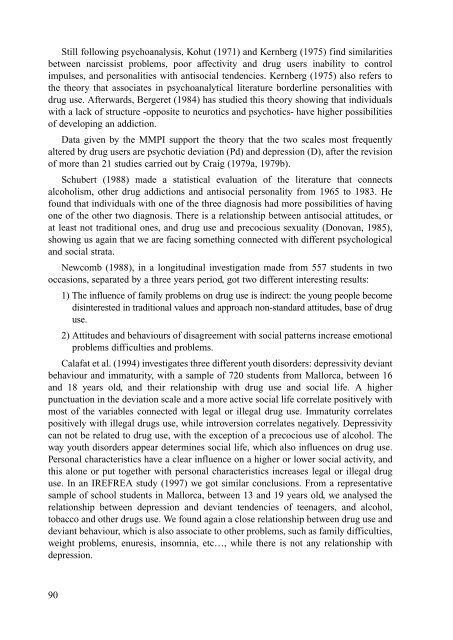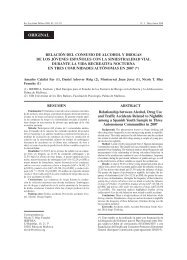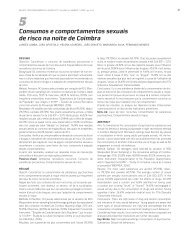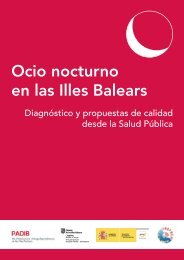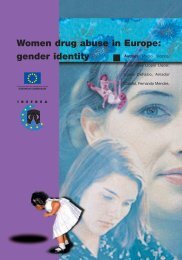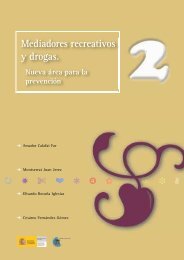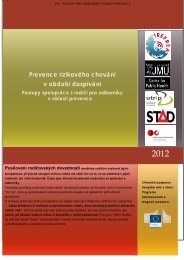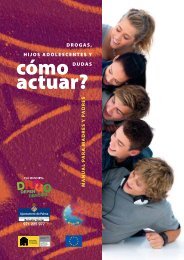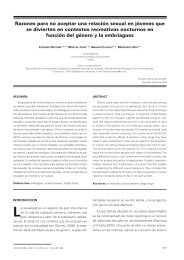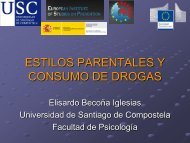Characteristics and social representation of ecstasy in Europe - Irefrea
Characteristics and social representation of ecstasy in Europe - Irefrea
Characteristics and social representation of ecstasy in Europe - Irefrea
You also want an ePaper? Increase the reach of your titles
YUMPU automatically turns print PDFs into web optimized ePapers that Google loves.
Still follow<strong>in</strong>g psychoanalysis, Kohut (1971) <strong>and</strong> Kernberg (1975) f<strong>in</strong>d similaritiesbetween narcissist problems, poor affectivity <strong>and</strong> drug users <strong>in</strong>ability to controlimpulses, <strong>and</strong> personalities with anti<strong>social</strong> tendencies. Kernberg (1975) also refers tothe theory that associates <strong>in</strong> psychoanalytical literature borderl<strong>in</strong>e personalities withdrug use. Afterwards, Bergeret (1984) has studied this theory show<strong>in</strong>g that <strong>in</strong>dividualswith a lack <strong>of</strong> structure -opposite to neurotics <strong>and</strong> psychotics- have higher possibilities<strong>of</strong> develop<strong>in</strong>g an addiction.Data given by the MMPI support the theory that the two scales most frequentlyaltered by drug users are psychotic deviation (Pd) <strong>and</strong> depression (D), after the revision<strong>of</strong> more than 21 studies carried out by Craig (1979a, 1979b).Schubert (1988) made a statistical evaluation <strong>of</strong> the literature that connectsalcoholism, other drug addictions <strong>and</strong> anti<strong>social</strong> personality from 1965 to 1983. Hefound that <strong>in</strong>dividuals with one <strong>of</strong> the three diagnosis had more possibilities <strong>of</strong> hav<strong>in</strong>gone <strong>of</strong> the other two diagnosis. There is a relationship between anti<strong>social</strong> attitudes, orat least not traditional ones, <strong>and</strong> drug use <strong>and</strong> precocious sexuality (Donovan, 1985),show<strong>in</strong>g us aga<strong>in</strong> that we are fac<strong>in</strong>g someth<strong>in</strong>g connected with different psychological<strong>and</strong> <strong>social</strong> strata.Newcomb (1988), <strong>in</strong> a longitud<strong>in</strong>al <strong>in</strong>vestigation made from 557 students <strong>in</strong> twooccasions, separated by a three years period, got two different <strong>in</strong>terest<strong>in</strong>g results:1) The <strong>in</strong>fluence <strong>of</strong> family problems on drug use is <strong>in</strong>direct: the young people becomedis<strong>in</strong>terested <strong>in</strong> traditional values <strong>and</strong> approach non-st<strong>and</strong>ard attitudes, base <strong>of</strong> druguse.2) Attitudes <strong>and</strong> behaviours <strong>of</strong> disagreement with <strong>social</strong> patterns <strong>in</strong>crease emotionalproblems difficulties <strong>and</strong> problems.Calafat et al. (1994) <strong>in</strong>vestigates three different youth disorders: depressivity deviantbehaviour <strong>and</strong> immaturity, with a sample <strong>of</strong> 720 students from Mallorca, between 16<strong>and</strong> 18 years old, <strong>and</strong> their relationship with drug use <strong>and</strong> <strong>social</strong> life. A higherpunctuation <strong>in</strong> the deviation scale <strong>and</strong> a more active <strong>social</strong> life correlate positively withmost <strong>of</strong> the variables connected with legal or illegal drug use. Immaturity correlatespositively with illegal drugs use, while <strong>in</strong>troversion correlates negatively. Depressivitycan not be related to drug use, with the exception <strong>of</strong> a precocious use <strong>of</strong> alcohol. Theway youth disorders appear determ<strong>in</strong>es <strong>social</strong> life, which also <strong>in</strong>fluences on drug use.Personal characteristics have a clear <strong>in</strong>fluence on a higher or lower <strong>social</strong> activity, <strong>and</strong>this alone or put together with personal characteristics <strong>in</strong>creases legal or illegal druguse. In an IREFREA study (1997) we got similar conclusions. From a representativesample <strong>of</strong> school students <strong>in</strong> Mallorca, between 13 <strong>and</strong> 19 years old, we analysed therelationship between depression <strong>and</strong> deviant tendencies <strong>of</strong> teenagers, <strong>and</strong> alcohol,tobacco <strong>and</strong> other drugs use. We found aga<strong>in</strong> a close relationship between drug use <strong>and</strong>deviant behaviour, which is also associate to other problems, such as family difficulties,weight problems, enuresis, <strong>in</strong>somnia, etc…, while there is not any relationship withdepression.90


